James Maliszewski's Blog, page 3
September 19, 2025
Reflections on the Revolution in Social Media
 I'm sorry to disappoint you, but, no, this is not that kind of post. I'm not here to rant nor to make reference to current events. Rather, I'm here to express some mild frustration with the fact that I'm obviously old and out of touch and have expectations about the way people engage with social media that are woefully out of date. And, by "social media," I mostly long form, online writing of the sort I produce on a regular basis rather than all those other sites where I have no presence whatsoever.
I'm sorry to disappoint you, but, no, this is not that kind of post. I'm not here to rant nor to make reference to current events. Rather, I'm here to express some mild frustration with the fact that I'm obviously old and out of touch and have expectations about the way people engage with social media that are woefully out of date. And, by "social media," I mostly long form, online writing of the sort I produce on a regular basis rather than all those other sites where I have no presence whatsoever.I recently wrote about the origins of Grognardia. While doing so, I was reminded of the early days of not just this blog but many others from the early days of the Old School Renaissance, many of which no longer exist. One of the things I most enjoyed about those early days – and that I miss nowadays – are the conversations that were engendered. On almost every blog, hardly a post went by without some comments, often many. These comments were a big part of what made reading blogs so compelling to me. Readers were actively engaged with what was being written and that regularly led to unexpectedly thoughtful and insightful discussions.
Similarly, blogs engaged with one another. There was a lot of cross-pollination in those days – as well as spirited argument. One of the reasons I look back so fondly on those early days is that there really was a sense that the OSR was a genuine community. That's a word I don't use lightly and indeed usually get suspicious anytime some makes use of it, but, in this case, I think it's apt. Even though we didn't always agree with one on specifics and occasionally got sidetracked by ultimately pointless disagreements, there was still a sense that we were all pulling in a similar, if not necessarily, the same direction.
Since I returned to blogging a little over five years ago, I feel like Rip Van Winkle. Granted, I was away nearly eight years, twice the length of time I had been blogging before I stopped. A lot had happened in the meantime, most significantly the rise of all manner of other platforms for online discussion. They all, in various ways, seem to have played a role in taking the focus away from blogs. That community feeling I once had seems largely to have evaporated, or at least to have shifted elsewhere. The vibrant engagement and thoughtful discussion that I so loved seem to be gone.
I bring all this up, because, as you know, I'm now posting regularly on three different platforms: this one, Substack, and Patreon. Each one has its own merits and flaws; each one allows me to do something slightly different. However, what's lacking in all three of them is much engagement with readers. I frequently feel as if it's the same four or five people who have anything to say and, while I'm grateful for such feedback, it's a far cry from what used to be commonplace on even the smallest of blogs. Has the center of gravity just shifted elsewhere, to sites and platforms I don't use? Is that what's happened?
Blogger, to be frank, is old and creaky. The only reason I still use it is that Grognardia has been on Blogger for seventeen years and the thought of transferring it, in whole or in part, to another site fills me with dread. I'm approaching 5000 posts and 80,000 comments, not to mention untold numbers of links into the site from places Wikipedia. Trying to move Grognardia to a more modern blogging platform is more than I can imagine doing. The task would be monumental and probably not worth the effort in the end.
At the same time, my experience with Substack has laid bare just how awful Blogger is. I used to be able to look at Grognardia's stats through Blogger and get a good sense of how many people were reading what posts and where they were coming from. I could also see what other sites were linking to Grognardia. All of this helped me to better engage with readers here and elsewhere and contributed to that sense of being part of a larger conversation about topics of mutual interest. In the last few months, that's proven even more difficult, as the stats seem implausible, thanks to being overwhelmed by bots.
Substack is, in this regard, so much better. I know exactly how many people are reading my posts and who's sharing them and where. Plus, the software is so much more user friendly and attractive than Blogger. I still get very little in the way of comments on my posts, but at least I know that people are reading what I write, which is something. Part of me just wants to shift over to Substack entirely, but I'm too wedded to Grognardia as it currently exists to do that. Plus, I have no more faith that it'll still exist in five years than I do that Blogger will.
That leaves Patreon, whose primary virtue, if I'm being honest, is that I make a little money from my writing. Whether people read what I write is only a little clearer than on Blogger but I assume that, if people are willing to pay for it, they must be enjoying it. That's gratifying, of course, and I'd be lying if I didn't say I wished more fans of my work weren't patrons, but it's still nothing like what I remember from the height of the OSR during Grognardia's First Age. Sure, I'd love to have so many patrons I could make an actual living solely off blogging, but, barring that, I'd settle for a better sense that people enjoy what I'm doing and make use of it in some fashion. No writer wants to feel as if he's shouting into the void.
This post came out a little more serious than I’d planned, but I want to be clear: I have no intention of shutting down Grognardia nor of giving up writing. If you’ve been following along on Substack or Patreon, you already know I’ve got plenty of irons in the fire and even here on Grognardia I feel like I’ve been producing more (and better) posts than I have in a long while. Writing is something I do because I need to and I’d keep at it even if no one else were paying attention. That said, it’s always more rewarding when the words I put out into the world spark conversation, reflection, or even just a bit of appreciation. I won’t pretend I don’t sometimes wish I saw more of that.Such is life, I suppose. Back to the salt mines!
September 17, 2025
Pulp Fantasy Library
September 16, 2025
Retrospective: GURPS Space
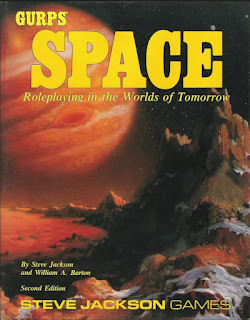 When Steve Jackson Games released
GURPS
in 1986, it was already clear what kind of roleplaying game it wanted to be. Unlike TSR’s Dungeons & Dragons or GDW’s Traveller, GURPS didn’t offer a default setting. Instead, it presented itself as a toolkit. It was intended as a modular, universal system one could bend toward whatever genre one preferred. What gave this claim weight wasn’t its rulebook, which was necessarily broad in its content, but its supplements. Each one attempted to answer the question, "Could this generic system really handle everything from dungeon crawls to post-apocalyptic road wars?"
When Steve Jackson Games released
GURPS
in 1986, it was already clear what kind of roleplaying game it wanted to be. Unlike TSR’s Dungeons & Dragons or GDW’s Traveller, GURPS didn’t offer a default setting. Instead, it presented itself as a toolkit. It was intended as a modular, universal system one could bend toward whatever genre one preferred. What gave this claim weight wasn’t its rulebook, which was necessarily broad in its content, but its supplements. Each one attempted to answer the question, "Could this generic system really handle everything from dungeon crawls to post-apocalyptic road wars?"One of the first such supplements Steve Jackson Games released was GURPS Space (1988), co-written by William A. Barton and Steve Jackson himself. In hindsight, it feels like one of the pivotal books of the line, the one that established GURPS’s reputation as more than just a flexible rules engine. It showed how you could take a broad genre, in this case, science fiction, in all its wildly different incarnations, and provide the referee with the tools needed to create (or recreate) any SF setting he could imagine.
By the late ’80s, science fiction roleplaying was in a state of flux. Traveller (in both its classic form and the then-new MegaTraveller) was still the reigning champion of the genre, but its dominance was showing cracks. West End’s Star Wars had burst onto the scene in 1987 with cinematic flair and wide acclaim, while TSR’s Star Frontiers had quietly stalled, its last release appearing in 1985. Against this backdrop, GURPS Space (1988) offered something no other SF RPG of the period did. It didn’t compete on the basis of a single setting, canonical future history, or a familiar franchise license. Instead, it handed referees the raw materials with which to build their own universes, be they grounded hard SF colonies, two-fisted pulp romps, or baroque planetary romances in the tradition of Vance and Burroughs.
It was precisely this approach that first caught my attention. At the time, I hadn’t yet played or even read GURPS. I knew it only dimly through advertisements, probably in Challenge magazine. But when I finally encountered GURPS Space, I was enchanted. Here was a book that didn’t tell me what science fiction ought to be but instead gave me the tools to make it whatever I wanted. I bought a copy almost immediately, followed by GURPS itself, largely on the strength of this one supplement. This would have been around 1990 or ’91, just after the release of the second edition, which is why the cover you see above accompanies this post rather than the original 1988 cover.
I was not disappointed. The worldbuilding section alone struck me as one of the most useful pieces of RPG design of its era. It provided step-by-step procedures for generating star systems, planets, ecologies, and cultures that felt simultaneously playable and evocative. The alien-design rules were equally impressive, demonstrating how the flexible mechanics of GURPS could be harnessed to create a wide array of nonhuman beings, from the truly strange to the more familiar. Even the treatment of technology impressed me. By abstracting progress into “tech levels” (an idea borrowed and refined from Traveller), the book offered a simple but powerful shorthand for describing entire societies without resorting to endless lists of weapons and gadgets (though, in time, GURPS would provide those as well).
Of course, GURPS Space bore the characteristic style of the line: dry, methodical, almost textbook-like. GURPS Space was never going to win any rewards for its writing, nor did it offer the convenience of a ready-made universe. This is both a strength and a weakness. For referees seeking inspiration and tools, it was definitely a godsend. For players wanting a game they could pick up and play straight away, however, it could feel intimidating or even sterile. Of course, that was the point. GURPS Space wasn’t trying to compete with the likes of Star Wars. It was offering something entirely different: freedom.
Taken as a whole, GURPS Space is one of the most significant supplements in the history of the line. It established the idea of GURPS as the “toolkit RPG,” a system whose real strength lay not just in its rules but in the genre handbooks that supported them. In my own case, it was the book that convinced me GURPS supplements were worth buying even if I wasn’t actively playing the game (which, truth be told, was most of the time). I wasn’t alone in this. Many referees I knew freely admitted to pillaging GURPS books for ideas and procedures to import into their homebrew campaigns. I strongly suspect Steve Jackson Games realized this and leaned into it, tailoring its supplements to appeal as much to curious referees as to dedicated GURPS players.
Looking back, it’s easy to see why GURPS Space made such an impression. It is fundamentally optimistic about exploration and the potential of alien contact, yet flexible enough to support darker, more cynical futures. It treats science fiction not as a single genre but as a sprawling field of traditions, each with its own possibilities. Above all, it captures what Steve Jackson Games was attempting to do with GURPS, namely, provide tools rather than a finished product and trust the imagination of referees and players to supply the rest.
That is ultimately why I still look back fondly GURPS Space, even though I don't play GURPS nor am I likely to do so anytime soon. Like so many of the supplements that followed in its wake, it doesn’t prescribe so much as inspire. Every table, every guideline, every suggestion is an invitation to ask questions and ponder answers. It’s not a book that hands you a ready-made campaign setting but one to spark ideas you might otherwise have not come up with on your own. In that sense, it’s less a manual than a launchpad, still capable of sending the imagination into orbit nearly four decades later.The Dreamlands Campaign
Here's another public post from my Patreon about the development of Dream-Quest. Because it's potentially a big change in my approach to the game, I thought it'd be worthwhile to share it more widely. I'm actively soliciting comments on what I've written here and whether or not it's a fruitful way forward. Whether you leave your comments over at Patreon or below, they will be much appreciated.
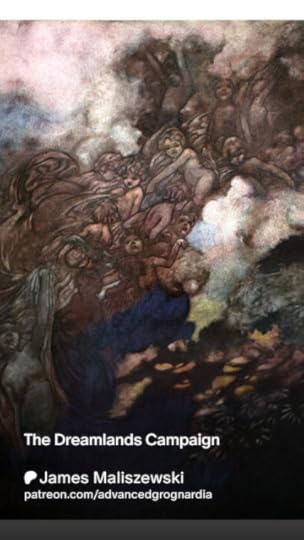
It's Clobberin' Time!
If you were reading Dragon magazine in the mid-1980s, advertisements for TSR's Marvel Super Heroes like this one were ubiquitous. The company worked very hard to get the word out about their new RPG and rightfully so. Though I was never (and still am not) much of a superhero guy, Jeff Grubb's design is so clever that I always had a blast playing MSH. That's no surprise: aside from (obviously) Dungeons & Dragons, Marvel Super Heroes is the only truly influential game TSR ever published and its impact on the hobby outlasted the game itself.
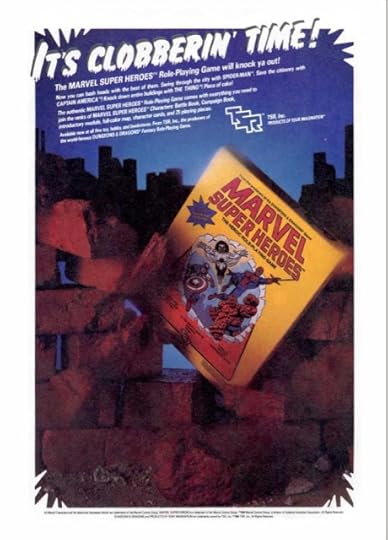
September 15, 2025
The Articles of Dragon: "Luna, The Empire and the Stars"
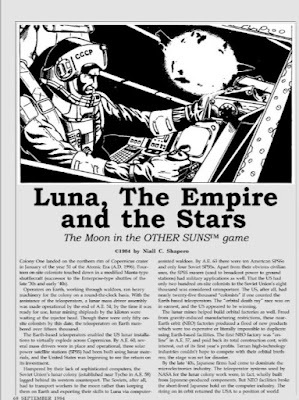 Heads-up: over the coming weeks and months, you'll be seeing a lot of posts about articles that appeared in the Ares Section of Dragon. To some extent, that's just a function of my own personal preference for science fiction over other genres. However, it's also a function of just how good so many of the articles that appeared in that section were or at least how strong my memory of reading them still is decades later.
Heads-up: over the coming weeks and months, you'll be seeing a lot of posts about articles that appeared in the Ares Section of Dragon. To some extent, that's just a function of my own personal preference for science fiction over other genres. However, it's also a function of just how good so many of the articles that appeared in that section were or at least how strong my memory of reading them still is decades later.
A good – but also peculiar – example of what I'm talking about appeared in issue #88 (August 1984), the same issue in which "The Marvel-Phil" premiered. The article in question is "Luna, The Empire and the Stars" by Niall C. Shapero. As its title suggests, it's another entry in the series detailing the state of Earth's Moon in various SF RPGs, such as Gamma World and Traveller. I was a big fan of these articles, all of which were intriguing in one way or another. This one was no different.
However, what did separate "Luna, The Empire and the Stars" from the others in the series is that it was about a science fiction roleplaying game that I had never read, let alone played – Other Suns. I knew of the game, of course. Its publisher, Fantasy Games Unlimited, ran regular advertisements for it in the pages of Dragon throughout 1983 and into 1984. Based on the fact that FGU had already published Space Opera, a kitchen sink SF RPG with a notoriously incomprehensible ruleset, I assumed that Other Suns would be more of the same.
While this assumption on my part would ultimately prove to be wildly incorrect, I plead that this article – by the game's designer no less! – played a huge role in leading me astray. "Luna, The Empire and the Stars" describes the future history of the Moon, starting with the establishment of Colony One near Copernicus Crater in in 51 AE (1996). The use of the Atomic Era dating system from H. Beam Piper's stories was the first of many things that gave me a false impression about Other Suns. Piper proposed an alternative dating system that used the detonation of the first atomic bomb in 1945 as its starting point. It's a little silly in some respects, but, from the perspective of a sci-fi author writing in the aftermath of the Second World War, it's somewhat understandable, given all the popular talk of "the Atomic Age" and the like.
Besides being wildly optimistic about the prospects of a manned lunar colony just a dozen years in the future of when the article was published, Shapero postulates many other equally implausible things, though, to be fair to him, he wasn't the only person to assume the Soviet Union would survive beyond the 20th century. The article likewise buys into speculations about the rise of Japan as a Great Power that were commonplace in the 1980s, especially in SF literature. However, in Shapero's vision, Japan's rise is quickly countered by the USA, forcing the Japanese to form an alliance with Communist China. Worsening relations between the Sino-Japanese alliance and America eventually lead to World War III, resulting in the deaths of two-thirds of Earth's population.
Fortunately, the American and Soviet lunar colonies are unaffected by the devastation and agree to work together to rebuild Earth in the aftermath of the war. Through their efforts, some semblance of normalcy returns to the planet, though life is still difficult. The newly-established world government is weak and corrupt, leading the military to launch a coup that eventually replaces it with a hereditary monarchy. The First Terran Empire is born. If you think this all sounds vaguely reminiscent of the CoDominium of Jerry Pournelle, you're not alone. That's what I thought too, when I first read the article and yet another reason why I assumed that Other Suns was a hard-edged military SF game.
I can't say that I loved this article or thought it was particularly innovative, but it intrigued me. In 1984, long before the Internet, I was limited in my knowledge of any games that I didn't see on the shelves of local stores. While it was certainly possible to make use of mail order to buy games I only ever saw advertised, I rarely availed myself of it, because I wanted to see the game and hold it in my hands before I bought it. This was especially true of games like Other Suns, whose advertisements were cryptic at best. That's why articles like "Luna, The Empire and the Stars" were so important to me. In principle, they gave me a sense of what the game was actually like.But, as I said in my original Retrospective post on Other Suns, this article did a very bad job of that. That probably explains why, even now, it looms so large in my memory.
Federation and Empire
September 14, 2025
Pulp Fantasy Library: The White Ship
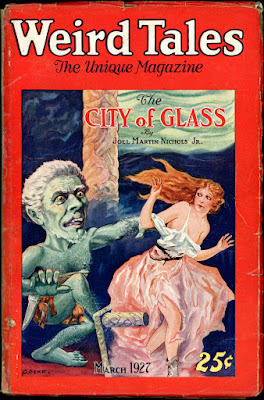 Last week, I mentioned that there's no clear consensus on which of H.P. Lovecraft's stories belong to his Dream Cycle – or indeed whether there even is such a thing at all. For his part, HPL typically referred to these works as his "Dunsanian fantasies" or something similar, reflecting the powerful influence of Anglo-Irish writer Lord Dunsany on his imagination when he wrote most of them. Lovecraft likewise never used the term "Dreamlands" in any of his published writing or private letters, though I don't personally think he would have objected to the coinage, given his admiration for Poe, whose famous poem "Dream-Land" (sometimes styled "Dreamland") surely echoes in the background.
Last week, I mentioned that there's no clear consensus on which of H.P. Lovecraft's stories belong to his Dream Cycle – or indeed whether there even is such a thing at all. For his part, HPL typically referred to these works as his "Dunsanian fantasies" or something similar, reflecting the powerful influence of Anglo-Irish writer Lord Dunsany on his imagination when he wrote most of them. Lovecraft likewise never used the term "Dreamlands" in any of his published writing or private letters, though I don't personally think he would have objected to the coinage, given his admiration for Poe, whose famous poem "Dream-Land" (sometimes styled "Dreamland") surely echoes in the background.
As I revisit these tales, I’ve tried to approach them with fresh eyes, setting aside, so far as possible, the layers of commentary, interpretation, and fan speculation that have built up over the decades. Those perspectives have their value, but I believe it’s essential to start with what Lovecraft actually wrote, not simply with what others have written about it. That’s not always easy, of course, but I note it here both to frame what I hope to do in this and future posts and to remind myself to follow through on that commitment.
Of all H.P. Lovecraft’s early, Dunsanian works, "The White Ship" is among the most overtly dreamlike. First published in the November 1919 issue of The United Amateur and later reprinted in the March 1927 issue of Weird Tales, it's narrated by a lighthouse keeper named Basil Elton. The story recounts Elton's voyage aboard a mysterious vessel crewed by a silent bearded man clad in white. Almost from the start, the tale announces its allegorical, fable-like nature, as Elton steps away from the familiar world of his lighthouse and embarks on a journey through seas that lead to fantastical realms, each embodying some abstract or moral quality. For example, he visits the Land of Zar (of beautiful but fleeting wonders), Thalarion (city of endless delights, haunted by madness), and others, before attempting to reach “the Land of Hope,” Cathuria, which lies beyond the Basalt Pillars of the West. The ship founders during its attempt to reach this forbidden land and Elton awakens back at his post, the beacon light having failed and a wrecked vessel lying on the rocks below.
Read on its own, "The White Ship" presents itself as a straightforward moral parable in the manner of Lord Dunsany. Its sequence of exotic realms, each more allegorical than the last, recalls the mythic procession of The Gods of Pegāna or the ornate wonders of A Dreamer’s Tales. Lovecraft’s imagination here leans heavily on lush description and dream-logic, crafting a narrative that feels more like an allegory than an adventure. Yet the story is not simply a dream. The framing device, with Basil Elton awakening at his lighthouse to discover a shipwreck on the rocks below, suggests that the voyage may have had real consequences – or at least that its reality cannot be easily dismissed. That ambiguity is central to the story’s effect and it helps explain why later readers and commentators so readily considered it part of the Dream Cycle.
More importantly, "The White Ship" contains clear anticipations of the themes and techniques that would define Lovecraft’s those later tales. The notion of voyaging into unseen realms, of lands lying just beyond the horizon of imagination, and of the ceaseless longing for a beauty that can never be fully attained all point forward to The Dream-Quest of Unknown Kadath. Basil Elton, like Randolph Carter after him, is not merely a dreamer but a figure alienated from ordinary life, dissatisfied with its limits, and compelled toward something more. In this way, the story functions as a prototype that's less developed than Lovecraft’s mature dream literature, but unmistakably the seedbed from which it grew.
Within the larger body of Lovecraft’s work, "The White Ship" occupies a liminal position. It predates the full flowering of his Dunsanian/Dreamlands stories, but its imagery and themes resonate strongly with those later tales. The forbidden allure of Thalarion, for instance, parallels the dangerous temptations Carter faces in his quest, while the longing for Cathuria foreshadows Carter’s pursuit of Kadath. Even the story’s framing device – of waking to find the dream has ended in loss – mirrors the bittersweet conclusion of The Dream-Quest. For these reasons, while it is not often remembered, I feel as if "The White Ship" is essential for understanding the eventual evolution of Lovecraft's fantasies.
In the end, "The White Ship" reveals a young Lovecraft still testing the boundaries of his imagination, experimenting with form, theme, and tone under the spell of Dunsany. It may not possess the philosophical depth of his later meditations on dream and memory nor the grandeur of his most ambitious fantasies, but it nevertheless contains the seeds of both. What it offers instead is an early glimpse of the author reaching beyond the mundane world toward something larger, stranger, and more beautiful than ordinary life can provide. For that reason, it rewards rereading, not only for its ornate imagery, but also for the insight it provides into Lovecraft’s growth as a dreamer and as a writer.September 12, 2025
"Call Me Ernie"
 Perhaps it's a side effect of my immersion in Lovecraft's Dreamlands, but the other night I had a very vivid dream whose contents I remembered when I awoke. That's quite unusual for me. Though I do dream regularly, I rarely remember the details for long (and I don't keep a dream journal to write them down before they fade from my memory).
Perhaps it's a side effect of my immersion in Lovecraft's Dreamlands, but the other night I had a very vivid dream whose contents I remembered when I awoke. That's quite unusual for me. Though I do dream regularly, I rarely remember the details for long (and I don't keep a dream journal to write them down before they fade from my memory).
In this dream, I was with a group of my friends – real friends who looked like they do in real life – and we were, for some reason going to Michael Moorcock's home. When we got there, we let ourselves in and proceeded to a large room that appeared to be a dining room or maybe a meeting room. There was a large, long table with a lot of chairs around it.
My friends and I sat down at the table, each claiming a spot. I claimed one near the head of the table, putting down my books and other belongings in front of me in order to secure my place. I did this so that I could be close to Moorcock's seat when he finally arrived. Though my friends filled many of the other seats, there were also a lot of empty seats remaining at the table.
When Moorcock didn't show up immediately, I grew impatient and told my friends I'd go look for him. I then got up and began to explore the halls of his home. I came across a number of rooms, all of them filled with books and works of art that I spent time examining. Then, I heard the sound of a door opening and I rushed back out to a hallway, where I saw Michael Moorcock heading toward the dining/meeting room. He saw me, smiled, and told me to follow him, which I did.
When I got back to the dining/meeting room, I discovered that my seat had been taken by someone else, someone I didn't know. In fact, all the seats at the table were now full, the only empty seats remaining were located at the edges of the room. I was annoyed that my friends had not saved my spot and even more annoyed that my books and other belongings were nowhere to be seen. I scanned the room, hoping I could find them but did not.
I reluctantly sat down at the edge of the room in one of the empty chairs as Moorcock took his place at the head of the table. He looked at me, seemingly knowing that I was distressed. I said, "Mr Moorcock, can you help me? I have a problem." He smiled and said, "Please, call me Ernie." He then pulled out a drawstring bag. Opening it, he pulled out an old cellphone with lots of accessories and then asked those arrayed around him, "Who'd like to buy this? I'm asking $70 for it but I'm willing to negotiate." I became even more annoyed.
That's when I woke up.September 11, 2025
For Their Own Sake
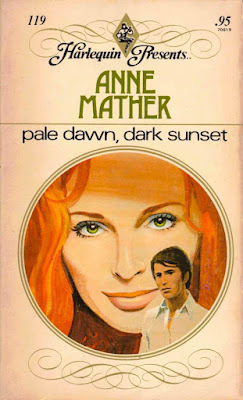 Earlier this week, I came across an article where the author professed her enjoyment of romance novels. What struck me was not her taste in books but that she felt compelled to justify it, as if liking romance fiction required an apology or a dissertation. So, she argued that romance novels aren’t as vapid or devoid of substance as people might assume and that, in fact, many contained hidden depths, social commentary, and so on. I don’t doubt that’s true in some cases, but the whole exercise struck me as unnecessary. Why does any form of entertainment need to be dressed up in the language of higher meaning before it’s considered legitimate? Why can’t we just say, "I like this because it entertains me?"
Earlier this week, I came across an article where the author professed her enjoyment of romance novels. What struck me was not her taste in books but that she felt compelled to justify it, as if liking romance fiction required an apology or a dissertation. So, she argued that romance novels aren’t as vapid or devoid of substance as people might assume and that, in fact, many contained hidden depths, social commentary, and so on. I don’t doubt that’s true in some cases, but the whole exercise struck me as unnecessary. Why does any form of entertainment need to be dressed up in the language of higher meaning before it’s considered legitimate? Why can’t we just say, "I like this because it entertains me?"This is something I think about often when it comes to the pulp fantasy literature I've championed on this blog since its beginnings. For decades, critics and fans alike have strained to rationalize their enjoyment of the pulps. They talk about how Robert E. Howard tapped into archetypal myth or how Fritz Leiber’s stories critique modernity or how Edgar Rice Burroughs anticipated later trends in speculative fiction. In a great many cases, this is, in fact, true, but I can't help but feel like it misses the point.
The pulps – and the stories published in their pages – existed to entertain. That's it. They were meant to fill idle hours with adventure, color, and excitement. They’re not sacred texts or secret manifestos and that’s fine. In fact, that’s more than fine. It’s wonderful.
I first started reading the stories I term "pulp fantasy" sometime after I first discovered Dungeons & Dragons. I would have been just on the cusp of my teen years – 10 or 11 years-old. I didn’t come to those stories because I wanted mythological resonance or literary depth. I came to them because the covers promised daring escapes, sinister sorcery, and faraway places unlike anything in my everyday life. For the most part, those stories delivered on their promises. Conan’s Hyborian Age, Leiber’s Lankhmar, and Burroughs’s Barsoom all burned themselves into my imagination not because they taught me something profound about the human condition, but because they were fun, fast, and unapologetically larger than life.
There seems to be a peculiar pressure to make sure our amusements are "worthy" of our time. Movies, books, and even roleplaying games are expected to carry some moral, political, or psychological weight. If they don’t, we’re told they’re “just entertainment,” as though that were an insult. Despite that, I find great joy in admitting that sometimes, I just want to read about sword-swinging barbarians, evil wizards, and lost cities with no greater purpose than escape.
Escapism itself isn’t a flaw. It’s one of literature’s oldest and most valuable functions. People have always turned to stories to be transported elsewhere, to forget the mundane for a while, and to inhabit another world. There’s no shame in that. If anything, I’d argue it’s essential, especially in times when the “real world” feels oppressive, difficult, or even just dull.
Of course, pulp fantasy stories can contain deeper meanings if you want to find them. Almost anything can, if you look hard enough. However, the fact that you don’t need to, that you can simply enjoy the ride without demanding justification, is, I'd wager, part of what gives them enduring power. When I pick up a yellowed paperback of Conan or Fafhrd and the Gray Mouser, I don’t feel guilty that I’m not wrestling with Dostoyevsky or Proust. I’m not reading them for enlightenment. I’m reading them because they’re fun.
Fun should be reason enough for anyone.James Maliszewski's Blog
- James Maliszewski's profile
- 3 followers



